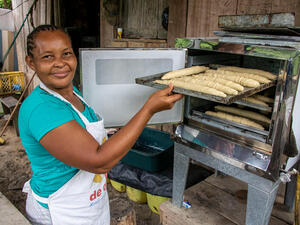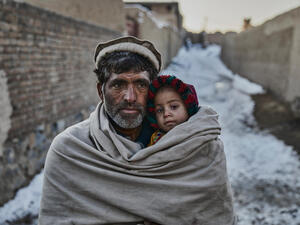UNHCR and UN Population Fund strengthen ties
UNHCR and UN Population Fund strengthen ties

High Commissioner for Refugees António Guterres and UNFPA Executive Director Thoraya Ahmed Obaid after the signing.
GENEVA, April 30 (UNHCR) - The UN refugee agency and the United Nations Population Fund (UNFPA) on Wednesday agreed to strengthen their partnership in areas such as reproductive health and countering sexual and gender-based violence (SGBV) and broaden cooperation to include statelessness and profiling of internally displaced people.
The sister organizations have been collaborating on issues of mutual interest for many years. This cooperation has grown even closer under the global reform process launched by the United Nations to improve the predictability, timeliness and effectiveness of humanitarian response.
"The newly signed letter is an attempt to broaden the cooperation between the agencies," said Karl Steinacker, head of UNHCR's field information and coordination support section.
The joint letter signed in Geneva on Wednesday by High Commissioner for Refugees António Guterres and UNFPA Executive Director Thoraya Ahmed Obaid will build on a memorandum of understanding signed by UNHCR and UNFPA in June 1995. It will also help the two UN agencies advance their respective mandates.
In UNHCR's case this means protecting, assisting, and finding durable solutions to the problems of refugees and addressing the issue of statelessness. For UNFPA, it entails promoting the right of every man, woman and child to enjoy good health and equal opportunity.
To ensure that refugees and internally displaced people (IDPs) can enjoy these rights, UNHCR and UNFPA have developed several initiatives, including the preparation of manuals on reproductive heath. UNFPA also supplies UNHCR with items, including male and female condoms, aimed at preventing unwanted pregnancies as well as the transmission of sexually transmitted infections in conflict zones.
The two agencies have also been collaborating on a photographic and video project designed to help de-stigmatize HIV/AIDS by showing that people living with HIV can lead a normal existence. "Positive Living, an exhibition for refugee settings" has toured refugee camps all over Africa.
UNHCR and UNFPA have also jointly engaged in opposing SGBV through the provision of training, guidelines and resources for the clinical management of rape. Together with the International Rescue Committee, they plan to develop an information management system to help develop adequate strategies to prevent and reduce the devastating impact of SGBV on refugee communities.
At a global level, obtaining accurate demographic and other relevant information on displaced populations remains a challenge that will benefit from specific collaboration between the two UN agencies.
At a country level, UNHCR and UNFPA will work together to provide UN country teams with an accurate profile of internally displaced, which is a precondition for effective relief and finding durable solutions.
UNFPA's expertise in the field of civil registration and in organizing population censuses, can contribute to the identification and prevention of statelessness. For example, registration of births helps to ensure that persons who are entitled to recognition as citizens are recognized as such. Additionally, population censuses can help identify the magnitude of statelessness.
As of the end of 2007, just under 3 million stateless people had been reported for 51 countries, compared to 5.9 million for 49 countries a year earlier. The drop is due to the regularization of the situation of 2.6 million people in Nepal and some 300,000 in Bangladesh.
However, UNHCR believes that up to 9 million more people are stateless but have not been reported as such. This highlights the need for accurate figures and the importance of the cooperation between UNFPA and UNHCR.









